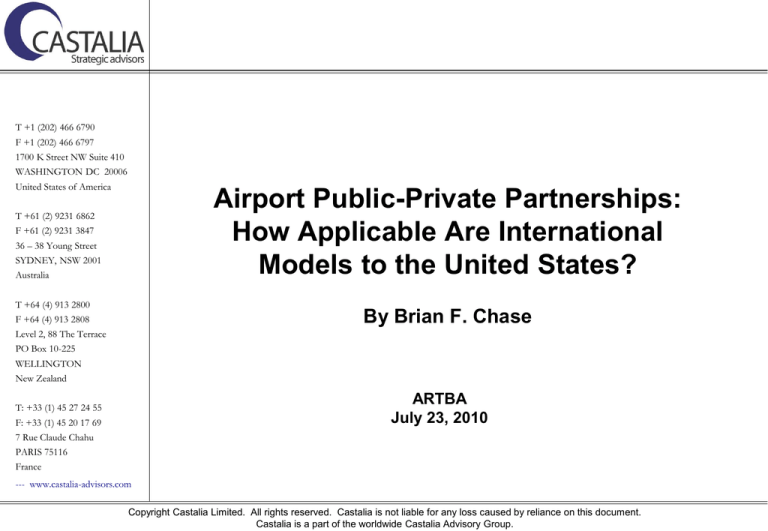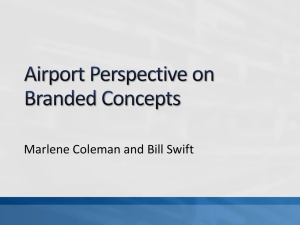
T +1 (202) 466 6790
F +1 (202) 466 6797
1700 K Street NW Suite 410
WASHINGTON DC 20006
United States of America
Airport Public-Private Partnerships:
How Applicable Are International
Models to the United States?
T +61 (2) 9231 6862
F +61 (2) 9231 3847
36 – 38 Young Street
SYDNEY, NSW 2001
Australia
T +64 (4) 913 2800
By Brian F. Chase
F +64 (4) 913 2808
Level 2, 88 The Terrace
PO Box 10-225
WELLINGTON
New Zealand
ARTBA
July 23, 2010
T: +33 (1) 45 27 24 55
F: +33 (1) 45 20 17 69
7 Rue Claude Chahu
PARIS 75116
France
--- www.castalia-advisors.com
Copyright Castalia Limited. All rights reserved. Castalia is not liable for any loss caused by reliance on this document.
Castalia is a part of the worldwide Castalia Advisory Group.
Summary of Presentation:
1. Airport PPPs that are being used globally
2. Airport PPPs that are being used in the
United States
3. Observations on what is (and is not) working
in the United States
4. Predictions
1
Two basic forms of airport PPPs being utilized globally:
1. Contractual PPPs
- Most common; especially in developing countries
2. Institutional PPPs
- Used in countries with well developed institutional
and regulatory capabilities
2
Why are airport PPPs being used?
Budgetary pressures on governments worldwide forcing them to explore
alternatives to traditional public sector provision of assets and services
Keen interest among institutional investors (e.g., public pension funds)
in alternative investment opportunities that can deliver relatively
predictable, income‐oriented and inflation-protected returns – such as
airports
Desire to reduce political interference with airport management decisions
International experience shows that new forms of private sector
participation can boost revenues and improve services at airports
Need for massive infrastructure investment across the world – including
at airports
3
Contractual PPPs:
Principal-agent relationship established between the public and
private sectors based solely on a written agreement. The public
partner delegates one or more airport-related tasks to its private
partners; these tasks may include developing, financing,
reconstructing or managing all or some part of an airport facility
Examples:
Management contract/operating lease/concession
Completed: Gatwick (2009); St. Petersburg (2009); Pristina (2010)
Pending:
Mali; Brazil; Peru
4
Institutional PPPs:
Private investor/operator and government authority are joint venture
partners in a corporatized airport entity (typically followed by an
IPO)
IPPPs are largely unknown in the United States because of state
constitutional prohibitions on public investment in business
corporations (resulted from ill-advised public investments in
canal and railroad companies during the19th century)
There are some interesting exceptions to this general ban that are
beginning to be explored and used (e.g., HAS Development Corp.)
Completed: Paris, Athens; Hamburg; YVRAS/Citi Infrastructure
Pending:
Prague, Seoul’s Incheon Airport, Poland
5
Observations on airport PPPs being utilized globally
Majority of world’s airports
remain government owned and
operated, despite the many
privatizations that have occurred
during past two decades
Nevertheless, local, regional and
national governments are
increasingly concluding that
airports might better be operated,
either entirely or partially, by the
private sector
Glasgow Prestwick Airport
6
Types of airport PPPs being used in the United States:
Types of airport PPPs being used in the United States:
-
Mostly contractual PPPs
-
More awareness of institutional PPPs, but so far only one
established to date involving a U.S. airport (HAS Development
Corp.)
Largely outside of FAA Airport Privatization Pilot Program (but
recent renewed interest in that program too)
Question:
Since the relevant regulatory framework exists in the United
States for contractual PPPs involving airports, why isn’t it
being used more frequently?
7
FAA Airport Privatization Pilot Program
Virtually ignored until 2008; due to mix of public airport authority
antipathy and high regulatory hurdles (limited pilot; 65% airline approval
requirement)
To date, only one project completed in 14 years (Stewart in 1999), so
perceived as high risk and expensive endeavor for PPP delivery
Since Midway, however, there has been greater interest in the program
Four of 5 slots now filled; one position remains available for a non-large
hub or GA airport
At least 10 other U.S. airports have expressed interest in privatization by
lease
Result: Contractual and even institutional PPPs are occurring at U.S.
airports, but mostly outside of the FAA’s cumbersome program (which
may soon become even more difficult to use – and thus less relevant)
8
Examples of U.S. Airport PPPs:
Orlando-Sanford Airport (TBI Airport Management)
In 2008, AIB One LLC, a GE Commercial Aviation Services (GECAS) company,
opened the privately-developed South Terminal at Austin-Bergstrom Airport in
Texas; it was then closed down a year later (due to economic downturn and swine
flu in Mexico) and returned to the city’s Aviation Department
In 2009, the first private greenfield commercial airport, Branson, opened. Operates
entirely outside of FAA’s remit, apart from safety and security requirements
Other examples:
-
HAS Development Corporation (with OMERS and ADC)
-
Panama City
JFK Terminal 4
Fort Worth Alliance Airport
Management contracts at commercial airports (Albany, Burbank, Indianapolis)
and GA airports (Teterboro and L.A. County)
Stewart (prior to 2007)
9
Five predictions on use of airport PPPs
(from most confident to most speculative)
10
Prediction #1: Airport investment activity involving public
pension funds will continue to grow (both in United States and
globally).
In 2008, first institutional PPP created involving U.S. airport, HAS
Development Corp., and public pension fund, OMERS
-
Was potential investor in Midway
Learned from example of SFO Enterprises
In 2009, the Ontario Teachers' Pension Plan (OTPP) completed a
transaction to increase its stake in Bristol International Airport to
49% and to sell its minority stake in Copenhagen Airport
In 2010, CalPERS acquired a 12.7% stake in London Gatwick via
direct investment (other investors include ADIA and S. Korean
National Pension Service)
11
Prediction #1 (continued): Airport investment activity involving public
pension funds will continue to grow (both in United States and globally).
Right now, private equity firm CVC Capital Partners (which
includes public pension fund investors) is leading an investor
group to buy infrastructure operator Abertis
-
Abertis has interests in 30 airports in 9 countries, which handle
more than 80 million passengers
-
It also (through its subsidiary, TBI) has total or partial
management contracts, from governments or local authorities,
at 5 U.S. airports:
Hartsfield-Jackson Atlanta International
Bob Hope
Middle Georgia Regional
Macon Downtown (GA airport)
Raleigh-Durham International
12
Prediction #2: If completed, Puerto Rico’s LMM will become the new poster
child for the FAA’s Airport Privatization Pilot Program (rather than Midway).
Emphasis on improving
airport services at lowest
government cost rather than
on asset monetization
Recommend review of Puerto
Rico PPP Authority’s related
feasibility study, available at:
www.P3.gov.pr
LMM International Airport
13
Prediction #3: PPPs will be used to provide airline service at
certain general aviation airports.
At least some one-airport metro areas need more airport capacity
Also, such metro areas typically suffer from high traffic congestion
across broad urban area
Example: Atlanta (Briscoe Field)
-
In FAA’s Airport Privatization Pilot Program
RFQ responses from private investors/operators due on Aug. 16
Goal is 10-gate terminal with dozens of fights/day
Seattle (Paine Field) and San Diego (McClellan-Palomar) also in process
of pursuing contractual PPPs
14
Prediction #4: More private investors will become interested in greenfield
private airport investment opportunities such as Branson.
$155 million invested by a
Connecticut businessman to
build the only privately-financed
commercial airport in the United
States
No FAA grant agreement
Several airlines already are using
it (Sun Country, AirTran, Frontier
and Branson AirExpress)
Another example of a potential PPP
project: Greenfield multimodal
freight/industrial airport near Dallas
Branson Airport
15
Prediction #5: U.S. airports will begin to explore using runway
congestion pricing.
Air Transport Assoc. challenged DOT program, but it was recently
upheld by a DC appellate court
Airports authorized to charge by time of day as well as by aircraft
weight
Goal is to reduce chronic airport delays and boost weight-based
landing fee revenues (which can be lower due to increased use of
regional jets)
16
Questions or comments?
Brian.Chase@castalia-advisors.com or Tel. (202) 466-6790
17







